
The Dissolution of RCCA
In 2014, RCCA dissolved and transferred its assets to the Krebser Fund for Rappahannock County Conservation (the “Krebser Fund’), which is housed within the Piedmont Foundation. The Piedmont Foundation is a 509(a)(3) supporting organization established to hold and manage the funds of the Piedmont Environmental Council. Two recent RCCA board members now serve on the Krebser Fund advisory board.
About RCCA
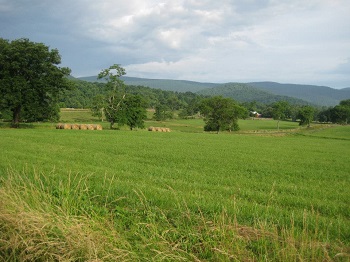
Photo by Carolyn Sedgwick
RCCA was founded in 1999 as a 501(c)(3) not-for-profit organization focused on preserving open space and farmland in Rappahannock County. Its mission was to ensure that Rappahannock County remains a scenic, rural community by promoting conservation easements and farmland preservation. RCCA served as an information resource for landowners considering conservation easements, was a large contributor to the Rappahannock Farmland Preservation Program, and had small grants to help defray easement costs for property owners. The founding board members of RCCA were Don Audette, Chris Bird, Bayard Catron, Bob Dennis, Douglas Ginsberg, Gary Light, Hal Hunter, Cliff Miller, Gerald Ochs, Chris Parrish, Sharon Pierce, Hildy Teegen, and Mitzie Young.
Project Highlights
- One of RCCA’s many accomplishments over the years was its contributing over $140,000 to the County’s Farmland Preservation Program. The Farmland Preservation Program is run by Rappahannock County and leverages matching funds from the state in order to purchase development rights from farmers. This program expands conservation options for farmers who are interested in donating a conservation easement but may be unable to do so from a financial standpoint.
RCCA helped initiate this program, which was then passed by the county Board of Supervisors in 2004. One of the main ways RCCA raised money for the Farmland Preservation Program was by holding an annual fundraiser called “The Evening View.” Each year this event was held on a different property under easement.
- RCCA produced a variety of outreach materials to promote conservation efforts in Rappahannock County. Among these were guides about conservation easements, the Farmland Preservation Program, tax credits, agricultural and forestal districts, and land use taxation. The group also was involved with various outreach events to help educate the community about conservation options.
- In 2012, RCCA launched a grant program through which it assisted donors of conservation easements with some of the upfront costs of a donation. RCCA assisted four landowners in Rappahannock as part of this program.
The RCCA produced this short film in 2009 to highlight some of the protected properties in the county:
Conservation Easement Stories
These stories were taken from the RCCA newsletter, Rappahannock Views.
The Perfect Place by Toni Egger
The first time I drove up the driveway to our farm, I was with our real estate agent, Alex Sharp, on my first day of “farm shopping” (as my husband Rob called it) in Rappahannock County. I had been looking elsewhere in Virginia for close to a year, and had come to Rappahannock at the suggestion of a friend who calls this county “the jewel of Virginia,” because of its tough zoning laws. As we drove up the driveway, I turned to Alex and said, “this is it.” Alex had just met me, and seemed a little puzzled by my certainty, and blurted out, “but you haven’t even seen the inside.”
He had. I told him I could fix the inside, but the old log house, nestled into a hill, and the views of rolling pasture horse-shoed by forest, was simply wonderful, and I knew instantly it’s what I’d been looking for all those months.
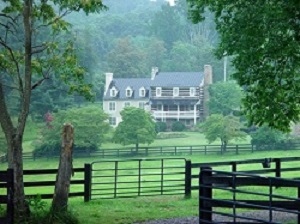
My husband Rob came out to see “the perfect place” the next day and we bought it several weeks later. The inside did indeed need to be fixed. The original house built around 1780 had been badly neglected, and 200 years later, an addition had been stuck on without much thought to space or aesthetics. While the house has a wonderful history, and quirky charm, it’s the property that sold us on the place. The forests, the pond, the gentle hills, black walnut trees, and the stream running through a back pasture, made this 70 acres, in our minds, unmatched and irreplaceable. We didn’t even know how rich the property was until sweat equity revealed two graveyards, a holly tree, and a row of beautiful old dogwoods buried under at least a decade’s growth of multiflora rose.
Even the Civil War has a footprint here. Digging in an overgrown garden one afternoon, I found a Confederate belt buckle buried under six inches of dirt. My husband, Robert E. Lee Taylor, grew up in Philadelphia, and had never connected with his southern roots. His great-grandfather, Walter Heron Taylor, was Robert E. Lee’s aide-de-camp, but, until we bought this farm, Rob’s name was the only connection to that heritage.
Because of the graveyards and the lifetimes of our house, I feel like a respectful visitor on my own farm. There are so many families who have come before us here, and there will, no doubt, be many after us. I consider us stewards of this property, and putting the farm in a conservation easement seemed like the best way to honor that responsibility. While we have the good fortune to live here, we will do little harm, and we will leave the place intact for another’s dreams and discovery. I’d like to think one of our two sons might live here one day – and they like to think that too – but whatever happens, they are fully supportive of our decision to preserve the integrity of the one place on Earth it was in our power to preserve.
No one in either Rob’s or my family has lived on a farm in any recent history, but I have wanted to be a farmer since I was a young child, and the fact that life has afforded me the opportunity in my 50s is a joy I appreciate every day. My husband was willing to go along with my dream, and has found a few of his own here; he has turned an old outbuilding into a woodworking shed, and he’s become something of a passionate vegetable gardener.
I am not a real farmer, in the sense that I don’t depend on the farm for my livelihood. But I get up each morning to care for horses, goats, and chickens, and I run to tend them after leaving my job as Executive Director of Headwaters in the evening. I am the only farmer my animals have, as Rob still works weekdays in DC. Yesterday, I came home minutes too late to catch the birth of the first kids born on Frog’s Leap farm. There they were, still wet and wildly wobbly. Their first time mother was properly tending to them and urging them to nurse. The moment was very real, and I am proud of the fact that our decision to put this small bit of Rappahannock in easement may allow future generations to enjoy such moments of their own.
White’s Rock Pile by Steve Kerchner
Lois and I began our lives together in Virginia in Great Falls, before the area became over developed – before the village was built and the stop light installed. Until then, we thought we were living in a pristine area. Dulles Airport was still in the middle of nowhere, but we sensed that it would change Leesburg and Loudoun County in dramatic ways. We launched our children from there, but then decided it was time to look for a place that was like Great Falls before it became GREAT FALLS! We found that special place in Rappahannock County and have been appreciative ever since. It is an escape that lives and breathes fresh air, beauty, and a high degree of community spirit and friendliness.
We arrived in Flint Hill and moved to our new home, Whitcairn, during the summer of 2002. Whitcairn was the name given to our property by the previous owner, Colonel James White. Its Scottish translation is “White’s rock pile.” We have continued to use that name for all things associated with our home, land, and business here in Rappahannock County.
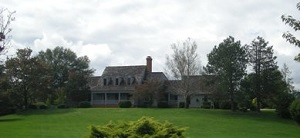
After immediately feeling the relief of not fighting the traffic on routes 7 and 66, one of the first things we did at Whitcairn was to walk the perimeter of our 75 acres. It was a WOW experience, but just a small taste of what lay in store for us as we continued to explore our new environment. We are still working on getting to know our community completely, and we have not been disappointed yet.
From a financial perspective, we were able to take advantage of lowered land use tax opportunities by availing our land to cattle belonging to Lindsay Eastham “next door” at Rucker Farm for a couple of years. However, we soon found that the beauty of the open spaces and the history of our property instilled a sense of responsibility for the land surrounding us and we felt it deserved more permanent protection.
We contacted the Virginia Outdoors Foundation (VOF) in 2006 and began the relatively easy process of placing our 75 acres in easement through VOF. To do that we had to merge two properties into a single easement, yet that was an easy choice since we wanted to preserve as much open space as we could and because we wanted to add Whitcairn to the scenic viewshed provided by all the easement-protected properties around us, which everyone is welcome to enjoy.
After VOF accepted the property as a potential easement, our next step was to obtain a professional appraisal of the property and retain a local attorney to help us record the easement in Richmond and Rappahannock County. The total cost to finalize the easement was approximately $6,000. However, through the sale of some of the tax credits granted by the Commonwealth for our donation, we were able to recoup more than the cost of the easement. It made the effort a win-win situation.
As a Board Member of the Rappahannock County Conservation Alliance (RCCA), I am pleased to say; even that cost can be reduced through a grant program established by our organization. RCCA recently established a grant fund for easement donors to help defray the costs I noted above to obtain an easement. For Lois and I, that would make a donation a win-win-win if we were beginning the process today.
We have no regrets about our choices and proudly announce it by displaying the green VOF sign at our entrance. We are grateful to have the opportunity to live in Rappahannock County and to all the others before us who had the foresight and the determination to pave the way for us.
Mount Vernon Farm by Cliff Miller
In 2003, my family put 604 acres of the farm we have been actively farming since 1827 into a permanent easement with the Virginia Outdoors Foundation. As representatives of the fifth and sixth generations to own this land, we did so with reverence and sober consideration in a process that was years in the making but obviously became important to do in the last several years! My great-great grandfather bought the original land in 1827 from the Reverend Francis ThorntonK— 519½ acres north of the Thornton River and encompassing much of Turkey Mountain. Over the years we have added to the holding, growing to more than 875 acres. Today we own approximately 825 acres that wraps around Sperryville’s north and east sides.
When Bob Dennis first approached my father and me more than 25 years ago, we were not enthusiastic, primarily because we did not want to limit the options of future generations, including my own. Although we were active in the financial management of the farm, we lived in Richmond and were here mainly on weekends. In 1990 I spent several years looking more closely at the farm and the Sperryville area. I became even more involved after 1997, at my father’s death, and in 2002 moved here full time. It was at that point I really understood what a uniquely special place Rappahannock is and how far-sighted yet fragile our political, social, and environmental planning is. It became clear that the land we owned was important to the future of the area and that forces were building that made protecting the land urgent. Through a combination of good planning and good luck, Rappahannock has preserved its rural integrity. My family was deep in the fabric of the land and we needed to do our part now.
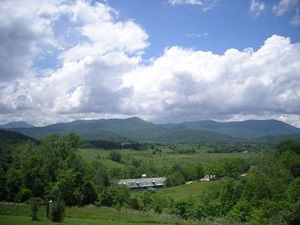
Most of our farm is in a limited liability company (LLC). There are seven members representing the fifth and sixth generations who own the assets of the LLC. As manager, I have relatively broad powers, but placing an easement on the land is not one of them. We have done some significant farm restructuring, and I have spent a great deal of time figuring out the best ways of making this property attractive for five more generations to enjoy and protect. I have also realized that future generations may choose to sell the farm and felt a responsibility to place some thoughtful limitations on the uses of it by future owners.
So, in the late spring of 2002, I began to explore with Leslie Grayson of VOF how to go about donating an easement. My core reason for doing it was because it seemed the right thing to do, but I knew I needed to understand the financial incentives and be able to present them to my fellow members. Initially I thought we would do a series of smaller easements over a longer period of time so as to use more of the incentives, but I soon realized we could craft one comprehensive document and still leave ourselves lots of flexibility. Every easement is unique, and ours is no exception. With our farm’s proximity to Sperryville, its having the Thornton River running through it, and its acreage on Turkey Mountain being very visible from the park, doing the wrong thing on this land would be felt well beyond the property itself.
I worked primarily with Leslie rather than through lawyers, and we adapted the standard form in a number of ways. I had one lawyer read through a draft when we were well along. Another lawyer did most of the property description work, and we had some survey work done to establish acreage. I attended several easement workshops put on by the Piedmont Environmental Council. I got an appraiser who specializes in easement properties, and he did a thorough job.
The financial numbers on a 600-acre parcel that is well placed are significant. As the major owner of the LLC, most of the tax benefits come to me, yet I will not be able to use many of them because I am not in that sort of financial position. All but one of my co-owners live outside of Virginia, and they can use the federal tax provisions. However, we all can use the very creative state provision that allows an owner to sell his or her unused tax credit—up to $100,000 per person per year for up to six years—to any other Virginia tax payer. The buyer of these tax credits should be willing to pay $70 to $80 to get a $100 deduction in taxes. On a large parcel, this can be a significant plus for the owner and the buyer of the credits. I expect to sell the credits myself and will assure the buyer that, if the credit is denied for some reason, I will return the buyer’s money.
I have found the easement process to be very pleasant: my fellow LLC members were unanimous in supporting the easement, the Virginia tax department was helpful, and VOF’s representative was outstanding. I believe we made our easement at the right time and encourage anyone wanting to take advantage of the opportunity to sell state tax credits to take action soon. It’s is a wonderful incentive for the farm family who wants to do right and also get a fair compensation—a benefit the continuation of which is at the pleasure of the General Assembly!
Mountain Green by Alex Sharp
Back in the late 1960’s and upon our father George Sharp’s retirement from the Navy, Dad and our mother Sally Sharp decided to start a new adventure. For reasons unknown to us still, they decided that they wanted to get into the apple business (this without any background in farming on either side!). Conducting an exhaustive search through the east coast apple growing regions from Maryland to North Carolina they finally answered an ad from Rappahannock County Real Estate Broker Ed Harris (many knew Miriam Harris at Jordan River Farm near Huntly). After trying to sell them his 900-acre Sommarbeth farm and another farm at Massie’s corner, Harris offered one property that might be on the market. At the moment we turned into the long willow lined driveway over the Rush River, we all knew that this was the one we’d been looking for. So, in late summer of 1968, the Sharps became only the third family to own the magical property “Mountain Green”.
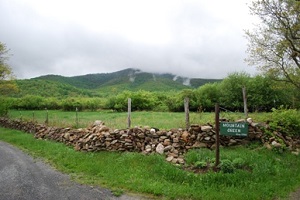
In 1784 Henry Miller made a gift of 366 acres to his son John Miller and this is the property now known as Mountain Green. John built the original two-over-two with a center hall stone and a wood house using stone from the neighboring fields. John had 13 children. His son Benjamin Franklin Miller inherited the house upon his father’s death. In about 1856, B.F. Miller built the grander front brick part of Mountain Green with its columns, high ceilings and open front porches up and down. After B.F. Miller died in a logging accident up in the mountains, his son John James Miller became the owner of Mountain Green.
The honorable John James Miller was a large farmer and orchardist, served in the lower branch of the legislature and on his death was a member of the Virginia State Senate, making him one of Rappahannock County’s most prominent citizens.
After 161 years in the Miller family, Mountain Green was sold to R.L. Cheatham of Richmond. The Cheathams modernized the house, closed in the front porches and made other improvements to the property. The Cheathams sold the farm to George and Sally Sharp in 1968.
Over the years, Mountain Green has been the site of very productive apple orchards, cattle farming, hay, grain, and orchard grass seed production. In the earlier part of the 20th century, Mountain Green was operated as a mule farm with the two lots behind the house know as the “Jack Lot” where the stud donkeys were kept. Farmers would ride their mares for miles to Mountain Green to breed their mares when the time was right.
Currently the Sharp Family owns the farm as a family corporation formed in the early 90’s. For over 20 years, the farm was the site of a pick-your-own apple orchard and now is used for hay production and grazing for a commercial cow and calf operation. Motivated by estate planning and love of the property, our parents put the whole property in an open space easement with the Virginia Outdoors Foundation. It is one of a group of contiguous easement protected properties ranging from Mountain Green all the way to Route 522 near Massie’s corner.
End of the Road by Hal and Beverly Hunter
We bought our land in 1968, moved here in 1976, raised two kids (now in their thirties), and did not consider a conservation easement or land-use taxation until we joined RCCA in 2000.
We had read some pamphlets about easements years ago but didn’t consider our land important enough for an easement because it doesn’t have any division rights under the current zoning. After we became more involved with RCCA, we became more aware of the importance of providing a protected buffer along the Rappahannock River. So, we donated a conservation easement to VOF.
We had paid taxes at full market value for more than thirty years, and we didn’t pay for an appraisal before making the donation. The reason why we didn’t take advantage of the tax credits is because we didn’t donate the easement for financial benefit. We donated it because, like many other Rappahannock residents, we wanted to help preserve the rural and scenic character of the county. We wanted to plant a conservation battle flag in Amissville, where development threats are building, hoping that our neighbors would follow our example. Still, donating the easement reduced our taxes to about one-third of what we used to pay and had the added benefit of helping our local schools by increasing the state’s portion of funding for them.
Our land is small by VOF standards—35 acres—but located on the Rappahannock River, which is officially designated as a “scenic river.” (It has a cave that a Civil War draft dodger used to escape his military obligations, which may have added some cachet in the eyes of VOF, but probably not.)
The steps to a donation were few and painless. Fellow Rappahannocker and easement expert Bob Dennis came over on a Sunday afternoon to talk us through the process. Then we checked with the kids, who thought it was a great idea to keep the place the way they remembered it growing up. After that, Kirstin, a friendly, overworked person from VOF, walked the boundaries with us and took some photos. Sharon Luke, a neighbor before she married Peter Luke and moved to F.T. Valley, drew up the legal papers—all boilerplate because there were no tax implications in the donation. We added a plat and some real estate records, and we were done.
As a nice addendum, at RCCA’s next annual meeting we had dinner as the organization’s guests because we were easement donors.
Manor Farm by Monira Rifaat
My home, Manor Farm, is a working cattle farm in Rappahannock County. This beautiful land—with its streams, rivers, woodlands, and pastures—will be preserved in perpetuity. It will remain open land, undivided and undeveloped. I am not the first owner. Previous owners carved out this farm from a larger track of land. I am the first owner to protect the land and a stretch of the Covington River by entering into a contract with the Virginia Outdoors Foundation.
My plan was clear: keep the farm in agriculture, preserve the open land, and preserve the pristine Covington River. As owner and operator of this cattle business, I have worked to protect the streams and rivers by entering into contracts with the Commonwealth of Virginia and the federal government to fence the cattle out of streams and to plant riparian buffers. This area of Virginia is in the Rappahannock River watershed, the waters of which flow into the Chesapeake Bay.
My children and grandchildren will inherit the farm, and they support these conservation concepts. They can build a prescribed number of homes for themselves on the undivided land. The farm can also be sold, and buyers will be bound to the conservation easement in perpetuity.
The contract between the VOF and me is a document in which I have outlined my preferences. The VOF’s board of directors approved the plan, and the document is recorded in the courthouse.
This gift of development rights has federal and Virginia tax consequences. An appraiser determines the value of the land before and after the easement is placed on it. When the state calculates the Local Composite Index for Rappahannock County, it accepts the valuation of my acres at land-use value (which is the same as land under conservation easement) and the land is taxed at land-use rates in perpetuity. This is extremely helpful to our local government, since it increases the state’s portion of funding for our schools.
I am hoping my neighbors will join me in this effort to preserve Rappahannock land.
Donating Our Easement—The More, the Merrier by Susan and Charley Strittmatter
We purchased our 50-plus acres of Rappahannock County around 1988, with plans to begin building our home in 5 years. Well, the draw of the beauty of the county was too strong. We moved in during the winter of 1992.
Our land is bordered by the Rappahannock River. Folks across the road from us border on the Jordan River. So, we have a stretch of about 6 miles of properties that have one of these rivers as a major influence on the nature of the land.
A friendly neighbor, dedicated to preserving land through conservation easements, worked on us (and residents along the entire road) for years. Our reservations came mostly in the form of a reluctance to tell our heirs what to do with the property. However, again the beauty of the county worked on us. The longer we lived here, the more we realized that, yes, we did want to tell our heirs what we wanted to have done with our property. We wanted the river and the land protected. We looked more seriously into it and, with the tax implications, felt that it was indeed time to proceed.
We began the conservation-easement process in 2000. The procedure was fairly simple. While we made some revisions to the standard form to allow for future farm structures, we did not realize the extent to which the terms could be negotiated. We had the help of a local attorney and hired an appraiser, but found the benefits far outweighed the costs.
In the 3 to 4 years since the easement sign was posted in a prominent place on our property, other properties around us have been placed in conservation easements. It had kind of a domino effect on our road. So, thanks to our friendly neighbor who kept encouraging all of us to take the step, our 6-mile stretch of Rappahannock County has only a few properties still unprotected— but, we’re working on them. After all, the more, the merrier.
Photo credits
The photography for the images on this page were generously provided over the last decade by the following photographers:
Ray Boc
Larry Grove
Doreen Jenkins
Nathan Jenkins
Rose Jenkins
Richard Lykes
Tom Murray
Francie Schroeder-Eastman
Martin Woodard
Alan Zuschlag
